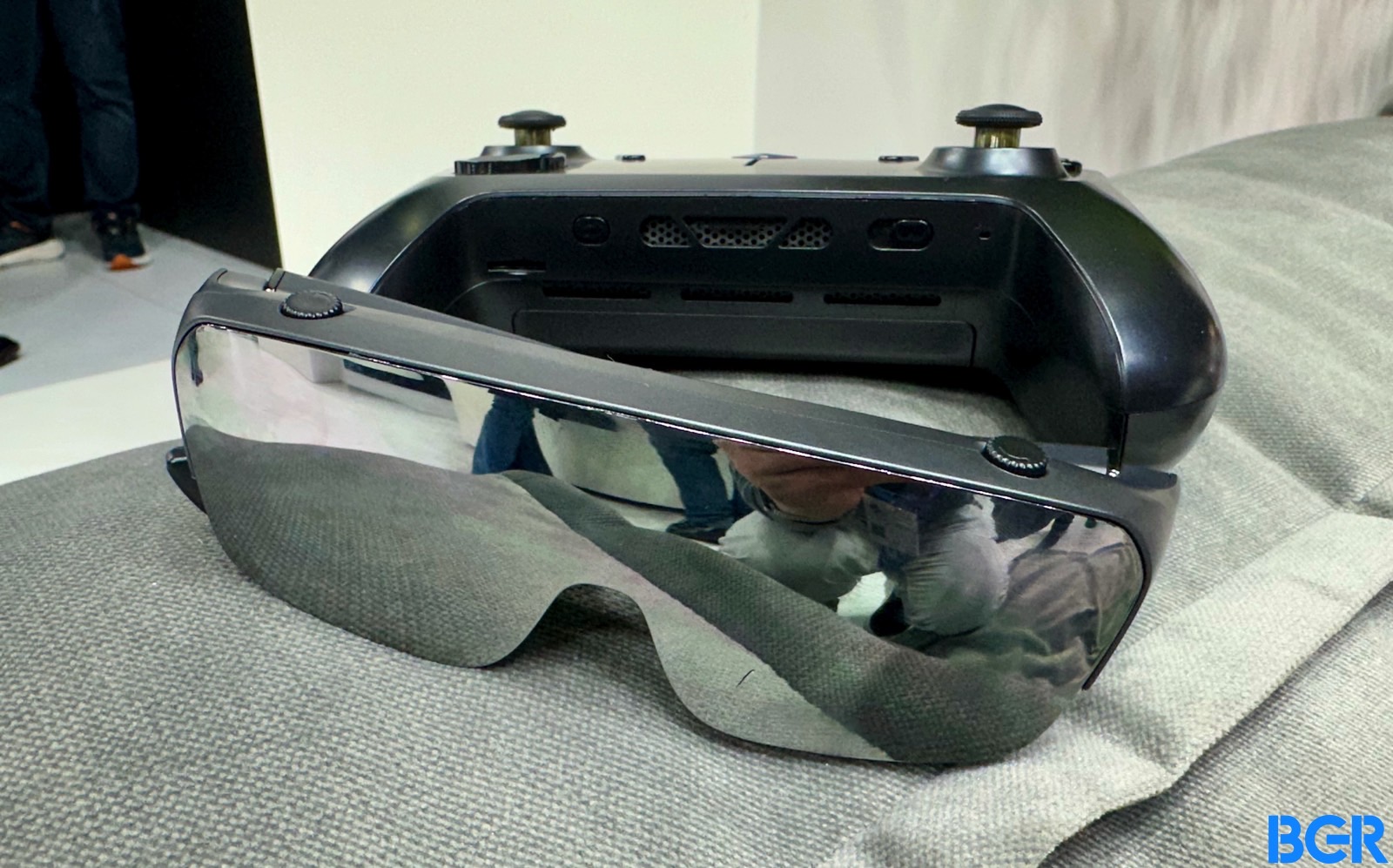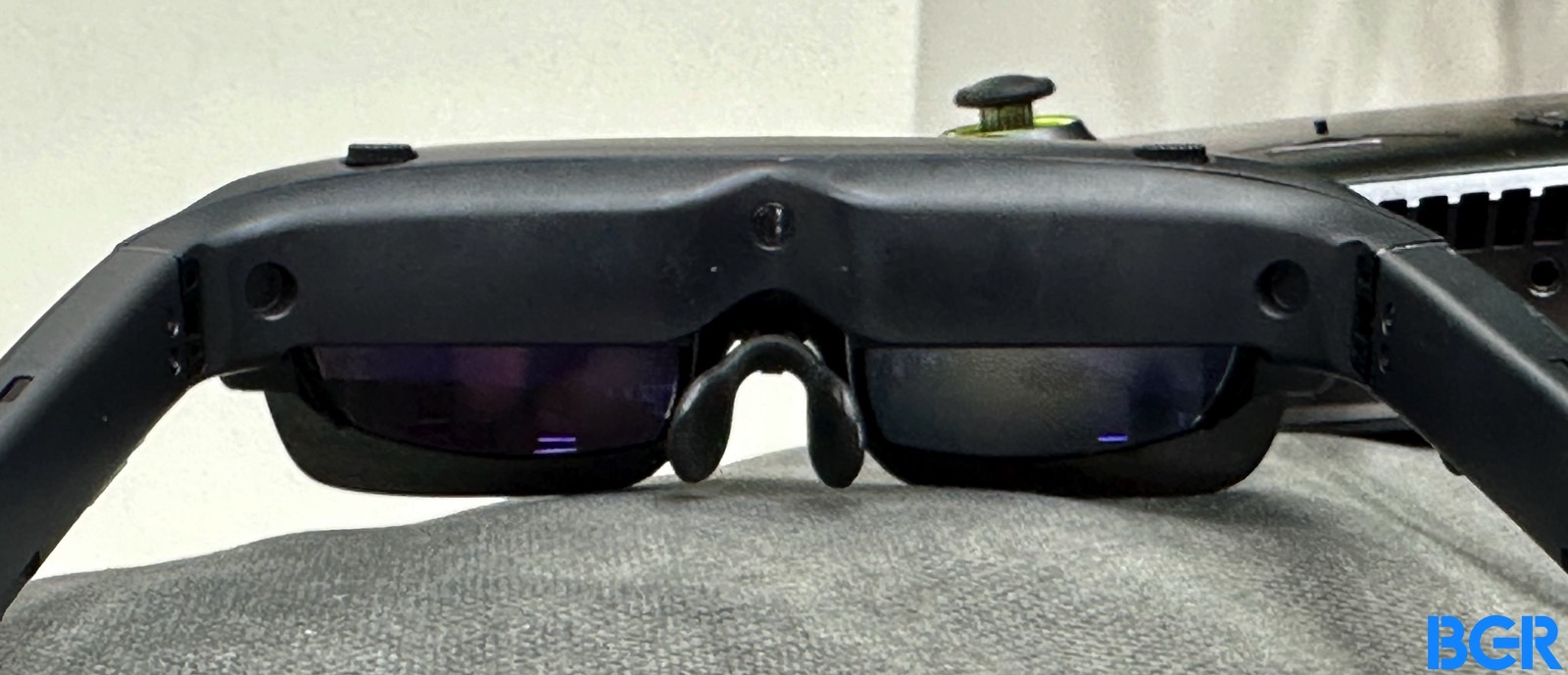I wasn’t thrilled with the AR glasses I tried at MWC last year. I said at the time that everyone designing these devices could only offer tethered experiences. I also said that the industry was waiting for Apple to lead the way with its own AR device.
Fast-forward to MWC 2024, and the Apple Vision Pro is now out in the US. It’s leading the way, and I expect more spatial computers to launch in the coming years as Apple perfects the Vision Pro and irons out the various issues that early adopters have highlighted.
As for the AR glasses that you might see at trade shows, they’re still tethered, which means you have to connect them via a USB-C cable to a computer to enjoy any sort of immersive content. And that content will only be as good as the quality of that display inside the glasses.
That was my general mindset on Wednesday heading into a demo of Tecno’s Pocket Go Windows AR gaming system.
I wasn’t expecting anything mind-blowing, as marketing reps understandably overhype these devices. But let me tell you this right now: The Tecno Pocket Go system blew my mind from the moment I put the AR glasses on. I had so many questions, and I wanted the demo to last as long as possible while knowing that others behind me wanted to test it out.
The AR display steals the show
So, what is the Tecno Pocket Go console? The Chinese company calls it the industry’s first Windows AR gaming set. The package consists of AR glasses (AR Pocket Vision) and a controller (Pocket Windows Handheld), which doubles as a Windows 11 computer. Connect the two via USB-C, and you get the Pocket Go console, which is unlike anything else on the market.
What really surprised me during the demo was the quality of the AR display. The Pocket Vision glasses feature a 0.71 micro-OLED 2K display that’s incredibly crisp. The glasses project the equivalent of a 215-inch TV some 20 feet away.

These are augmented reality glasses, but “reality” isn’t a core part of the experience. You can see real-life objects in your peripheral vision, of course, but that’s about it. And I didn’t care about any of that as I was running around in the game while moving my head in real life or while sitting in a bean bag chair asking questions about the Pocket Go.
The game ran smoothly, the controls were super responsive, and the virtual display moved as I moved my head. The headset is very comfortable, too. It’s thicker than a pair of prescription glasses but still far less heavy than most VR or AR headsets. It even features adjustable diopter settings to accommodate your vision requirements.
I thought Tecno had a winner in that AR display experience from the moment I put the Pocket Vision headset on my head. But I was also surprised to learn this device was an actual Windows 11 PC. It’s not Android or some proprietary operating system.

Therefore, you can play any high-end PC game on this Windows 11 machine while having the game show up on a virtual 215-inch display in front of your eyes.
On top of that, the Pocket Windows Handheld device can work as a Windows 11 computer. You can connect a keyboard and a mouse to it, and you’d get a spatial computer of sorts. If you use it with the AR Pocket Vision headset, that is. I haven’t actually tried the PC experience on the Pocket Go, but Tecno assured me it’s possible.
Not only that, but the AR Pocket Vision works with other devices. You could hook it up to a smartphone, Nintendo Switch, a PS5, a Steam Deck, or another PC.
The powerful Windows 11 PC
The AR Pocket Vision isn’t meant to work as a standalone device, but Tecno packed plenty of tech in the glasses. In addition to that stunning screen, you get a six-axis gyroscope and an AI algorithm that helps track your head movements.
The glasses feature “N’BASS nano-structured acoustic materials and TECNO’s unique vibration enhancement algorithm to convert in-game sounds into nuanced vibrations,” per Tecno.

I realized after the fact that the sound must have been off or the volume was down during the demo. I did focus more on my conversation with the Tecno rep about the Pocket Go system than the in-game sounds. The controller gave me force feedback when something crashed into me. It must have been a car of some sort.
Considering the demo was relatively short, I could not assess whether the AR Pocket Vision would induce nausea. This can be an issue when it comes to wearable headsets. But I felt fine while using it.
As for the Windows 11 PC performance, Tecno equipped the controller with “the latest gaming CPU.” That means 8 cores, 16 threads, and up to 5.1GHz speed. Put differently, this is a 35W chip doing the heavy lifting for those high-end games. It’s paired with 16GB of LPDDR5 RAM and 1TB of storage. A PC-grade cooling system ensures proper heat dissipation.

Finally, the controller has a replaceable 50Wh battery for extended gaming sessions. Tenco didn’t share a battery estimate with us, however.
The controller felt slightly larger than traditional gaming console controllers, but I did not experience any issues handling it, nor did it get too warm during the demo.
Price and release date
What I didn’t like about the gaming experience was the lack of ammo in the game. Those testing the headset before me emptied the clip, and I was stuck with melee weapons in whatever game was playing on the headset. This tells you immediately that I’m not a gamer. It also tells you that plenty of people have tried it before me.
But trust me when I say this: the AR Pocket Vision experience is amazing, and the display is a huge part of that. That screen alone is a big upgrade over last year’s slew of AR experiences.

Will the commercial product be as good? I can only hope so. Hopefully, the Pocket Go will work great as a gaming system and Windows PC. Again, I only tested playing a game on the Pocket Go. We’ll have to wait for Tecno to ship it to see what else it can do.
When can you buy one? We still aren’t sure. The Pocket Go is coming later this year, but Tecno has yet to announce the markets that will first get it.
As for the price, a Tecno rep told me that the Pocket Go might sell for around $1,000. That gets you both the AR Pocket Vision and the Pocket Windows Handheld. The company might sell the two gadgets separately, as they do not have to be paired. As I said, you could use the AR glasses with other gadgets. The Windows 11 PC would work with any type of display, not just virtual ones.








